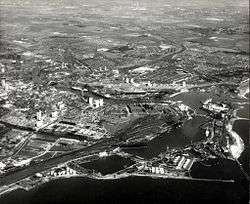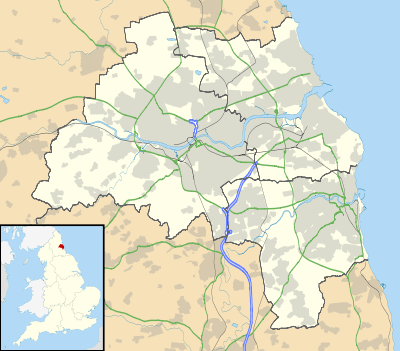Hendon, Sunderland
| Hendon | |
 Hendon docks, 1969 |
|
 Hendon |
|
| Population | 12,597 (2011.Ward)[1] |
|---|---|
| Metropolitan borough | City of Sunderland |
| Metropolitan county | Tyne and Wear |
| Region | North East |
| Country | England |
| Sovereign state | United Kingdom |
| Post town | SUNDERLAND |
| Postcode district | SR1 |
| Dialling code | 0191 |
| Police | Northumbria |
| Fire | Tyne and Wear |
| Ambulance | North East |
| EU Parliament | North East England |
| UK Parliament | Sunderland South |
|
|
Coordinates: 54°54′01″N 1°22′05″W / 54.9002°N 1.36807°W
Hendon is an eastern area of the City of Sunderland in North East England, the location of much heavy industry and Victorian terraces and high-rise residential tower blocks.
Shipbuilding in Sunderland began in Hendon with the opening of a shipyard by Thomas Menvill in 1346.[2]
The old east end of Sunderland was home to Sunderland Barracks until the 1930s.[3] They were located on the south side near the south docks, near present-day Warren Court (formerly known as Warren Street).[4] The first aluminium bascule bridge in the world, spanned the junction of Hendon and Hudson Docks. It suffered from bimetallic corrosion and was demolished in 1977.
The Victoria Hall Disaster occurred in the area on 16 June 1883 when 183 children died during a crush in a theatre, while running down the stairs in search of free toys. It remains the worst stampede disaster in British history.
The area was home to Sunderland AFC's first ground, The Blue House Field.[5] The club was founded at the nearby Hendon Board School in 1879 by James Allen. Partly on its site now is the Raich Carter Sports Centre, named after a famous footballer born in the area.
Hendon contains the primary schools of Hudson Road and Valley Road. It is home to many shops along Villette Road such as Gregg's. Some main roads in Hendon are Villette Road, Commercial Road, Hendon Road, Gray Road, Mowbray Road and Hendon Valley Road. The "long streets" in Hendon (Cairo Street, Hastings Street, Canon Cockin Street, St Leonard's Street, Percy Terrace and Hunter Terrace) are very long, consisting of rows of Terraced Houses and even stretching into a new area: Grangetown.
References
- ↑ "Sunderland Ward population 2011". Retrieved 21 July 2015.
- ↑ "Wear - History - History of shipbuilding on Wearside". BBC. 2008-01-18. Retrieved 2016-10-16.
- ↑ "Sunderland : 'Old Sunderland'". Wearside History. Retrieved 16 October 2016.
- ↑ Milburn, Geoffrey E.; Miller, S.T. (1989), Sunderland: River, Town and People, Thomas Reed Publications, ISBN 0-947637-06-0
- ↑ Days, p 3
Sources
- Paul Days; John Hudson; John Hudson; Bernard Callaghan (1 December 1999). Sunderland AFC: The Official History 1879–2000. Business Education Publishers Ltd. p. 336. ISBN 978-0-9536984-1-7. ASIN 0953698416.